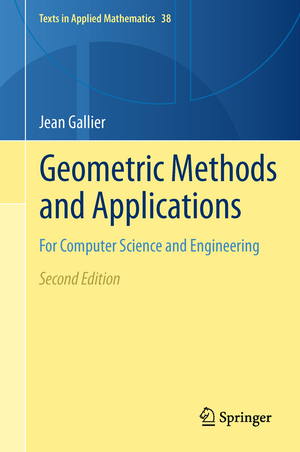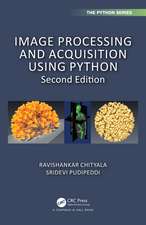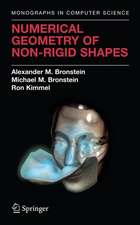Geometric Methods and Applications: For Computer Science and Engineering: Texts in Applied Mathematics, cartea 38
Autor Jean Gallieren Limba Engleză Hardback – 21 iun 2011
This book covers the following topics: affine geometry, projective geometry, Euclidean geometry, convex sets, SVD and principal component analysis, manifolds and Lie groups, quadratic optimization, basics of differential geometry, and a glimpse of computational geometry (Voronoi diagrams and Delaunay triangulations). Some practical applications of the concepts presented in this book include computer vision, more specifically contour grouping, motion interpolation, and robot kinematics.
In this extensively updated second edition, more material on convex sets, Farkas’s lemma, quadratic optimization and the Schur complement have been added. The chapter on SVD has been greatly expanded and now includes a presentation of PCA.
The book is well illustrated and has chapter summaries and a large number of exercises throughout. It will be of interest to a wide audience including computer scientists, mathematicians, and engineers.
Reviews of first edition:
"Gallier's book will be a useful source for anyone interested in applications of geometrical methods to solve problems that arise in various branches of engineering. It may help to develop the sophisticated concepts from the more advanced parts of geometry into useful tools for applications." (Mathematical Reviews, 2001)
"...it will be useful as a reference book for postgraduates wishing to find the connection between their current problem and the underlying geometry." (The Australian Mathematical Society, 2001)
| Toate formatele și edițiile | Preț | Express |
|---|---|---|
| Paperback (1) | 547.60 lei 43-57 zile | |
| Springer – 19 apr 2013 | 547.60 lei 43-57 zile | |
| Hardback (1) | 723.65 lei 43-57 zile | |
| Springer – 21 iun 2011 | 723.65 lei 43-57 zile |
Din seria Texts in Applied Mathematics
- 17%
 Preț: 368.61 lei
Preț: 368.61 lei - 17%
 Preț: 364.42 lei
Preț: 364.42 lei -
 Preț: 494.87 lei
Preț: 494.87 lei - 19%
 Preț: 510.59 lei
Preț: 510.59 lei - 17%
 Preț: 498.74 lei
Preț: 498.74 lei -
 Preț: 463.79 lei
Preț: 463.79 lei -
 Preț: 471.91 lei
Preț: 471.91 lei - 13%
 Preț: 427.17 lei
Preț: 427.17 lei -
 Preț: 447.93 lei
Preț: 447.93 lei - 8%
 Preț: 528.53 lei
Preț: 528.53 lei - 19%
 Preț: 586.76 lei
Preț: 586.76 lei - 15%
 Preț: 461.29 lei
Preț: 461.29 lei -
 Preț: 404.13 lei
Preț: 404.13 lei - 17%
 Preț: 364.52 lei
Preț: 364.52 lei - 17%
 Preț: 363.12 lei
Preț: 363.12 lei - 15%
 Preț: 594.73 lei
Preț: 594.73 lei -
 Preț: 492.20 lei
Preț: 492.20 lei - 15%
 Preț: 606.82 lei
Preț: 606.82 lei -
 Preț: 406.25 lei
Preț: 406.25 lei - 15%
 Preț: 534.60 lei
Preț: 534.60 lei - 18%
 Preț: 1233.03 lei
Preț: 1233.03 lei -
 Preț: 404.13 lei
Preț: 404.13 lei - 15%
 Preț: 662.27 lei
Preț: 662.27 lei - 15%
 Preț: 511.70 lei
Preț: 511.70 lei -
 Preț: 404.89 lei
Preț: 404.89 lei -
 Preț: 399.29 lei
Preț: 399.29 lei -
 Preț: 464.00 lei
Preț: 464.00 lei - 15%
 Preț: 535.34 lei
Preț: 535.34 lei - 15%
 Preț: 681.60 lei
Preț: 681.60 lei - 15%
 Preț: 732.81 lei
Preț: 732.81 lei -
 Preț: 394.87 lei
Preț: 394.87 lei
Preț: 723.65 lei
Preț vechi: 851.35 lei
-15% Nou
138.49€ • 144.05$ • 114.33£
Carte tipărită la comandă
Livrare economică 14-28 aprilie
Specificații
ISBN-10: 1441999604
Pagini: 698
Ilustrații: XXVIII, 680 p.
Dimensiuni: 155 x 235 x 43 mm
Greutate: 1.16 kg
Ediția:2nd ed. 2011
Editura: Springer
Colecția Springer
Seria Texts in Applied Mathematics
Locul publicării:New York, NY, United States
Public țintă
GraduateCuprins
Introduction.- Basics of Affine Geometry.- Basic Properties of Convex Sets.- Embedding an Affine Space in a Vector Space.- Basics of Projective Geometry.- Basics of Euclidean Geometry.- Separating and Supporting Hyperplanes; Polar Duality.- Polytopes and Polyhedra.- The Cartan–Dieudonn´e Theorem.- The Quaternions and the Spaces S3, SU(2), SO(3), and RP3 .- Dirichlet–Voronoi Diagrams.- Basics of Hermitian Geometry.- Spectral Theorems.- Singular Value Decomposition (SVD) and Polar Form.- Applications of SVD and Pseudo-Inverses.- Quadratic Optimization Problems.- Schur Complements and Applications.- Quadratic Optimization and Contour Grouping.- Basics of Manifolds and Classical Lie Groups.- Basics of the Differential Geometry of Curves.- Basics of the Differential Geometry of Surfaces.- Appendix.- References.- Symbol Index.- IndexAppendix.- References.- Symbol Index.- Index
Recenzii
"This is a worthwhile book to have in the library of any univeristy which is involved with these areas of computer science." (The Mathematical Gazette, 2002)
"The treatment of each topic is in depth and to the point. It is a rigorous theorem-proof approach on the one hand, but there are plenty of comments and remarks that make for easier reading." (SIAM Review, 2002)
From the reviews of the second edition:
“The book contains a valuable collection of modern geometric methods and algorithms readily prepared for solving problems occurring in computer science and engineering. … The second edition is even more comprehensive and puts more emphasis on the links between different fields. It can be recommended to anybody who is interested in modern geometry and its applications.” (Anton Gfrerrer, Zentralblatt MATH, Vol. 1247, 2012)
“Anyone who likes to read about geometry, differential geometry, linear algebra, or Lie theory should find something of interest in this book. … this is, of course, a text in geometry, and many aspects of it are covered. … this book is filled with interesting mathematics, superbly presented. Aside from its potential use as a text, the book should be looked at by anyone who uses or is interested in the topics covered. It is highly recommended.” (Mark Hunacek, The Mathematical Association of America, September, 2011)
Notă biografică
Jean Gallier is a Professor at the University of Pennsylvania in the Computer and Information Science Department at the School of Engineering and Applied Science.
Textul de pe ultima copertă
This book is an introduction to the fundamental concepts and tools needed for solving problems of a geometric nature using a computer. It attempts to fill the gap between standard geometry books, which are primarily theoretical, and applied books on computer graphics, computer vision, robotics, or machine learning.
This book covers the following topics: affine geometry, projective geometry, Euclidean geometry, convex sets, SVD and principal component analysis, manifolds and Lie groups, quadratic optimization, basics of differential geometry, and a glimpse of computational geometry (Voronoi diagrams and Delaunay triangulations). Some practical applications of the concepts presented in this book include computer vision, more specifically contour grouping, motion interpolation, and robot kinematics.
In this extensively updated second edition, more material on convex sets, Farkas’s lemma, quadratic optimization and the Schur complement have been added. The chapter on SVD has been greatly expanded and now includes a presentation of PCA.
The book is well illustrated and has chapter summaries and a large number of exercises throughout. It will be of interest to a wide audience including computer scientists, mathematicians, and engineers.
Reviews of first edition:
"Gallier's book will be a useful source for anyone interested in applications of geometrical methods to solve problems that arise in various branches of engineering. It may help to develop the sophisticated concepts from the more advanced parts of geometry into useful tools for applications." (Mathematical Reviews, 2001)
"...it will be useful as a reference book for postgraduates wishing to find the connection between their current problem and the underlying geometry." (The Australian Mathematical Society, 2001)
Caracteristici
Chapters have been expanded
Offers an introduction to affine, projective, computational, and Euclidean geometry, basics of differential geometry and Lie groups
Descriere
This book is an introduction to the fundamental concepts and tools needed for solving problems of a geometric nature using a computer. It attempts to fill the gap between standard geometry books, which are primarily theoretical, and applied books on computer graphics, computer vision, robotics, or machine learning.
This book covers the following topics: affine geometry, projective geometry, Euclidean geometry, convex sets, SVD and principal component analysis, manifolds and Lie groups, quadratic optimization, basics of differential geometry, and a glimpse of computational geometry (Voronoi diagrams and Delaunay triangulations). Some practical applications of the concepts presented in this book include computer vision, more specifically contour grouping, motion interpolation, and robot kinematics.
In this extensively updated second edition, more material on convex sets, Farkas’s lemma, quadratic optimization and the Schur complement have been added. The chapter on SVD has been greatly expanded and now includes a presentation of PCA.
The book is well illustrated and has chapter summaries and a large number of exercises throughout. It will be of interest to a wide audience including computer scientists, mathematicians, and engineers.
Reviews of first edition:
"Gallier's book will be a useful source for anyone interested in applications of geometrical methods to solve problems that arise in various branches of engineering. It may help to develop the sophisticated concepts from the more advanced parts of geometry into useful tools for applications." (Mathematical Reviews, 2001)
"...it will be useful as a reference book for postgraduates wishing to find the connection between their current problem and the underlying geometry." (The Australian Mathematical Society, 2001)




























